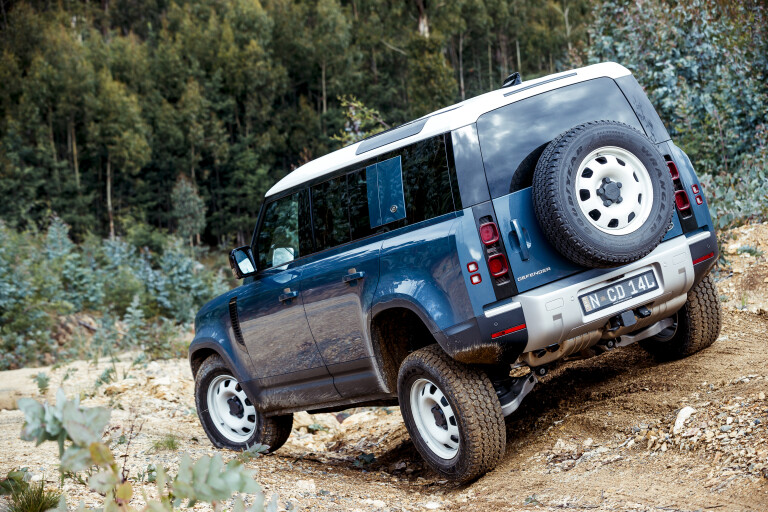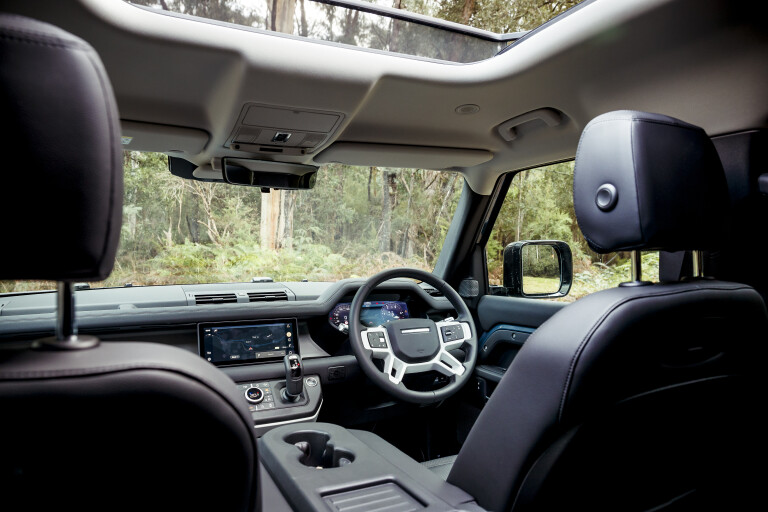
Almost a year after the first shipment of MY2021 Land Rover Defenders lobbed on Australian shores the 2022 models have arrived, and with them the introduction of the six-cylinder diesel ‘Ingenium’ engines.
There was a very small batch of four-cylinder diesels among those 2021 Defenders, but they were all pre-sold and most of the 2021 vehicles were powered by the petrol P400 six-cylinder drivetrain.
Australia is primarily a diesel market when it comes to large 4x4 vehicles, so many potential Defender buyers were keenly awaiting the arrival of the new engine which has landed in two states of tune: D250 and D300 variants.

Our first taste comes with the D250, fitted here to a Defender 110 S along with a few options that are also new to the 2022 specification.
The base price for the car is $91,000, but start adding things like the height-adjustable air suspension ($1309); Off Road Capability pack ($2210); rear diff lock ($806); heated front seats ($806); white painted roof ($2171); and metallic blue paint ($2060) among others, and the price of this particular car climbs to $111,860 plus ORC.

"Put your foot down on the throttle and hold the gears in the eight-speed auto and the six-pot puts out a sweet-sounding growl"
POWERTRAIN & PERFORMANCE
The new Ingenium diesel is a 3.0-litre in-line six with twin turbochargers set up in a sequential system. In this D250 trim it makes a healthy 183kW and 570Nm. Step up to the D300 engine, which is only available in SE spec and above, and you’re getting 220kW and 650Nm from the same hardware.
The Ingenium family of engines is modular so, put simply, the six-cylinder is the same as the four-pot, with another pair of 250cc chambers tacked on to the end. Like the other Ingenium engines, the six-pot diesel runs a 48V system in what Land Rover calls a mild-hybrid system; although, there is no electric-driven drive delivered back to the powertrain here.
The low tune of the D250 never leaves you wanting more in the 110. It’s a smooth and refined engine, providing a linear power delivery through its rev range. It’s also very quiet inside the cabin and, when compared to the P400 petrol engine, you’d be hard-pressed to pick that this is the diesel during normal driving.
Put your foot down on the throttle and hold the gears in the eight-speed auto and the six-pot puts out a sweet-sounding growl, again comparable to a performance petrol six.
During our week with the D250 it returned 11.37L/100km of fuel consumption, compared to high 16s previously recorded during similar drives in the P400 petrol Defender. If the P400 is the performance engine in the range and the D250 is the economical one, we can’t wait to find the middle ground in the D300!

ON ROAD RIDE & HANDLING
Everything we’ve said about driving the P400 Defender in the past applies equally to the D250. There’s no discernible difference in the weight over the front axle that you might find in many diesel-driven vehicles over their petrol stablemates, while the power is sufficient if not up to that of the P400.
The height-adjustable air suspension does a fine job of isolating the body from rough roads and irregularities in the surface, and controls the vehicle over harsh corrugations better than anything with a live axle ever could. If there’s any more lean in the taller tyres fitted to the 18-inch wheels on this car, we didn’t notice it.

OFF-ROAD
We’re yet to drive a new Defender on coil-spring suspension, and even this S-spec car is equipped with air suspension which is optional in this grade. Thus equipped, the Defender is one of the most capable off-road vehicles you can get from the showroom. Ground clearance, tractive ability, outward vision, wheel travel and technology are all class-leading. Fitted with a set of aggressive off-road tyres, the new Defender could be unstoppable.
Yes, you do need to keep the suspension up high to get the best of that clearance, and the ride quality suffers a bit at that level, but that’s something you can work around. The Terrain Response system isn’t as simple as it used to be, but the new ‘Auto’ setting means you can forget about it over all but the most specialised terrain such as sand or rugged rocks, when you can manually select the specific setting to suit.
There really is nothing else on the market that can combine this level of off-road ability with the on-road poise and dynamics of the new Defender.
One gripe for off-road driving is where the front towing point is mounted behind a plastic panel, which you need to remove before you head off-road if you think you might be needing quick access to said point.

CABIN & ACCOMMODATION
IT might only be the S model in the range but this low-grade Defender doesn’t leave you wanting anything inside. The seats are a mix of leather and textile materials and offer comfortable seating for six passengers over two rows.
Yes, that’s right, this car is fitted with the optional ‘jump seat’ up front which allows three across the front row. This is an $1853 option and choosing it precludes the possibility of equipping the car with a third row of seats. So no, you can’t have an eight-seat Defender because of the payload and GVM.
The centre front backrest folds forward when not in use to provide an armrest with cupholders for the outboard passengers. With the backrest upright, its headrest blocks any vision out the back of the car via the rear view mirror. This car is fitted with the ‘Clearsight’ rear-view mirror which projects an image of behind the vehicle from a camera mounted on the roof, but it’s a weird perspective I personally can’t get used to.
You’d have to really need the jump seat to order it, but I could see it being more useful in the Hardtop Defender models with just front-row seats.

Another option on this car is the $4810 power-fold canvas opening roof. Sunroofs are something you either love or hate. Personally I like the fresh air and extra light you can get in the cab through an open roof, or just the clear glass roof of a conventional sunroof.
This canvas roof only offers open or closed options without the in-between of letting the light through a closed glass roof, but it should be lighter than having the weight off a glass panel up there. A sliding panoramic glass sunroof is a $4490 option.
As mentioned, this car has heated front seats, another option that I like. Unfortunately, operating the seat heating has fallen into the abyss that so many functions have in that you need to access the controls through a menu in the dash screen which takes longer than simply hitting a button.
It’s a little annoyance in an interior that is otherwise a functional and pleasant place to ride.

PRACTICALITIES
The Defender is nothing if not practical in every regard. Its ease of use for general day-to-day driving makes it easy to live with, despite a few interior niggles mentioned. While it’s no longer a commercial vehicle, the Defender remains the most practical model in the Land Rover range – as you would expect it to be.
The addition of the diesel engines amplifies its usability. Like other Defender models the D250 offers a full 3500kg towing capacity and in this trim gives a 785kg payload. With the suspension in its off-road setting, the wading depth is a massive 900mm and the ground clearance is ahead of any other new vehicle. The cargo area is massive and the seats fold flat to make it even bigger. There are tie-down points and a 12V outlet in the back for storing and powering your gear.
The steel wheels are a no-cost option and should theoretically be stronger than alloy wheels if you are concerned about durability. The 18-inch wheels can only be fitted to diesel-fuelled Defenders as they run a smaller brake size than the petrol models. The 255/70R18 tyre size isn’t massively common but you should be able to fit the more common 265/65R18s as a replacement if needed.

THE VERDICT
While options like a fabric roof, centre jump seat and steel wheels might be a cool, nostalgic trip back to the Land Rovers of old, they don’t necessarily make much sense on this all-new Land Rover. For me, a glass roof offers more functionality than the fabric one; the centre front seat is only something you would only use on occasions and costs you storage space; and a $100K-plus modern SUV deserves a set of nice alloy wheels in place of steelies.
These options are what you might call nostalgic, but they don’t take away from the fact the Defender is one of the best all-round 4x4 wagons you can buy. No other vehicle can match its breadth of ability; from its semi-luxury feel to its best-in-class off-road ability, it stands up to any competitor.
The introduction of the diesel engines to the range just adds further to the appeal, giving buyers more options, improved drivability and a longer touring range.
SPECS
| ENGINE | In-line 6-cyl turbocharged diesel |
| CAPACITY | 2996cc |
| MAX POWER | 183kW at 4000rpm |
| MAX TORQUE | 570Nm from 1250 to 2250rpm |
| TRANSMISSION | 8-speed automatic |
| CRAWL RATIO | 53.34:1 |
| 4X4 SYSTEM | Full-time 4x4 with high and low range |
| CONSTRUCTION | 5-door, 6-seat wagon, monocoque chassis |
| FRONT SUSPENSION | Independent height-adjustable air |
| REAR SUSPENSION | Independent height-adjustable air |
| TYRES/WHEELS | 255/70 on 18in steel wheels |
| KERB WEIGHT | 2415kg |
| GVM | 3200kg |
| PAYLOAD | 785kg |
| TOWING CAPACITY | 3500kg |
| SEATING CAPACITY | 6 |
| FUEL TANK | 89L |
| ADR FUEL CLAIM* | 7.9L/100km |
| TEST FUEL USE | 11.31L/100km |
| DEPARTURE ANGLE | 40° |
| RAMPOVER ANGLE | 27.8° |
| APPROACH ANGLE | 37.5° |
| WADING DEPTH | 900mm |
| GROUND CLEARANCE | 291mm |



COMMENTS